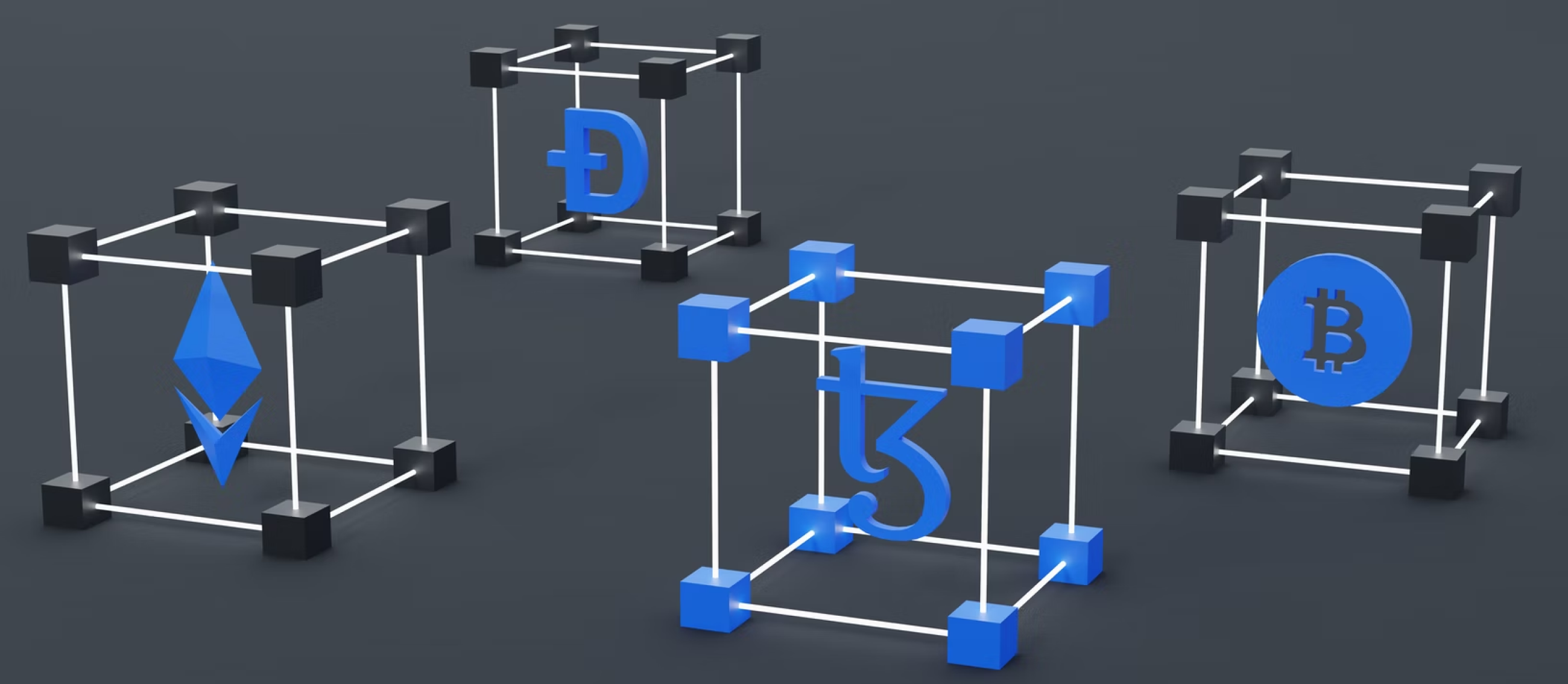In this article, we take a closer look at blockchain technology, as we define blockchain technology, the use cases of blockchain, alongside statistics, and the advantages and disadvantages of blockchain.“What is Blockchain technology?” is a question many business owners, leaders, and senior executives are asking these days.
Beyond Bitcoin and cryptocurrencies, Blockchain is a technology solution that can harness the power of organizations to make them more efficient and secure and handle larger volumes of data at scale.
For companies wanting to innovate securely, at scale, blockchain is the way forward. More businesses than ever are starting to use this technology, from financial services firms to healthcare companies to supply chain and transportation giants. Transactions, contracts, and data transfers are moving from traditional software platforms to blockchain-based networks.
In this article, we take a closer look at blockchain technology, as we define blockchain technology, the use cases of blockchain, alongside statistics, and the advantages and disadvantages of blockchain.

What is Blockchain?
Blockchain is more than just cryptocurrency. Although Bitcoin, the world’s first cryptocurrency, introduced the world to Blockchain in 2008, the use of this technology goes far beyond trading, investing, and exchanging digital currencies.
Here’s a broader definition of Blockchain:
“Blockchain is a shared, immutable ledger that facilitates the process of recording transactions and tracking assets in a business network. An asset can be tangible (a house, car, cash, land) or intangible (intellectual property, patents, copyrights, branding). Virtually anything of value can be tracked and traded on a blockchain network, reducing risk and cutting costs for all involved.”
How does Blockchain work?
Any Blockchain — whether Ethereum-based or built on another platform — needs to include the following key features; otherwise, it’s not a blockchain.
A Distributed Ledger
Imagine cloud-based software where everyone who has can edit, make changes, and verify anything anyone else does with the software. In many ways, that’s how blockchain technology works. It’s a network where everyone has access to the distributed ledger at the network’s core.
A blockchain ledger contains an immutable (unalterable and, therefore, tamper-proof) record of every transaction. Records can only be logged once on this network, avoiding duplication issues that’s commonplace within business databases and networks.
Smart Contracts
A smart contract is a set of rules for transactions. Once the participants of a smart contract have met the conditions for those rules, the actions that the contract has been designed to take will be implemented automatically.
Smart contracts can be created for almost any purpose, e.g. conditions for corporate bond transfers, buying and selling real estate, travel insurance terms, and so much more.
Now, here’s how all of this fits together and actually works.
Every block is connected to the ones before and after it, forming a “chain”
Once an asset moves from one place to another, or from one owner to the next, these blocks form an immutable “chain,” recording every transaction that occurs. Individual blocks record the time and value of every transaction, and the chain itself prevents blocks from being tampered with and records altered.
Security and public validation (even within private, corporate blockchain networks, where access is only granted to senior people within a business) are integral to the smooth operation of blockchain networks.
Secure, Immutable Transaction Records
When talking about “transactions” on blockchain-based networks, we aren’t only referring to buying and selling cryptocurrencies and tokens. Those examples are merely one use case of the incredible potential of blockchain technology.
A transaction on a blockchain network can be anything, such as the transfer and storage of data, or a smart contract being executed. Blockchain-based networks can collect, store and transfer enormous amounts of data. Businesses using blockchain technology in operational processes can rest easy knowing this data is secure.
No one can tamper with a record once it’s been logged on a blockchain (making them immutable), and in the event of an error occurring or attempted tampering, a new transaction must be logged to reverse the error, and both records would remain visible on the public ledger.
Every transaction, as it occurs in real-time, is recorded on the public ledger as a “block” of data
A transaction can record the movement of something tangible (e.g., the sale of a product, or the execution of a smart contract) or intangible (e.g., an intellectual or digital asset, such as a Non-Fungible Token (NFT)).
Data blocks can record any information you need, or when you buy something using a blockchain network, the seller will provide the data within a smart contract. Businesses can record as much information as they need within these data blocks, and every time a transaction occurs, a “block” is recorded on the public ledger.
Transactions are grouped together in an irreversible and uneditable chain: a “Blockchain”
As more transactions are recorded, they are grouped together, creating a tamper-proof “blockchain.” Ledger transactions validate themselves using smart contracts, and a public ledger — or blockchain — can be further verified by every stakeholder within the network.
Once those basics are in place, there are other considerations and numerous ways Blockchain technology can be used. We outline this, alongside examples, pros, cons, and statistics about Blockchain technology in the rest of this article.
Now let’s take a look at use cases, examples of blockchain applications and networks, and the pros and cons of businesses using blockchain technology.
Use cases of Blockchain
Blockchain is already being used across a wide variety of industries, with numerous enterprise corporations creating and implementing private blockchain networks. In many ways, the uptake of blockchain technology has been quicker and more pervasive than artificial intelligence (AI) or machine learning (ML) across countless sectors. Although many associate blockchain with cryptocurrencies, such as Ethereum, Bitcoin, and thousands of others, the use of this technology extends far and wide. According to IBM, blockchain is already used across the following sectors: healthcare, government, supply chains, retail, media, oil and gas, telecoms, manufacturing, insurance, financial services, travel, and transportation.

5 Examples of Blockchain Applications
-
#1: Ethereum
is the world’s second most popular cryptocurrency, after Bitcoin. It’s also the underlying technology behind thousands of other blockchain-based innovations, such as other crypto networks and digital assets, including NFTs.
-
#2: IBM Blockchain
is a private, centralized blockchain developed and maintained for enterprise companies by IBM. Unlike some public blockchains, this comes with a user-friendly interface, making it easy to use for people without needing to train them on using blockchain technology.
-
#3: Hyperledger Fabric
is a series of interconnected, highly-secure, blockchain-based enterprise tools and applications developed by The Linux Foundation. Using Hyperledger Fabric improves enterprise security, accelerates processing times, and gives companies the ability to delay their own private blockchain networks.
-
#4: R3 Corda
is a blockchain-based network, a public ledger for financial institutions that was developed by a consortium of banks and technology companies, including Bank of America, Santander, HSBC, Intel, and Microsoft. Transactions on the R3 Corda blockchain are processed in real-time, giving it an advantage over traditional financial platforms and other blockchain networks. Plus, it comes with the enhanced security you would expect from a blockchain platform.
-
#5: ConsenSys Quorum
is a customized version of an Ethereum-based blockchain network developed by JPMorgan, the global financial institution. ConsenSys Quorum speeds up transactions between financial institutions and includes numerous privacy enhancements making it more compatible with GDPR in Europe and CCPA in the US. ConsenSys provides enterprise applications that align with and are powered by Ethereum-based tools. JPMorgan, the South African Reserve Bank, and numerous others are already using this or are in the process of rolling it out.
Blockchain Statistics
According to several studies, these blockchain statistics are worth remembering:
- The Blockchain technology market is already currently worth $4.9 billion (as of 2021), and is expected to grow at a Compound Annual Growth Rate (CAGR) of 68.4%, reaching a market size of $67.4 billion in 2026.
- In 2021, global spending on blockchain solutions exceeded $6.1 billion.
- According to PwC economists, Blockchain could boost the world economy $1.76 trillion by 2030 (1.4% of global GDP, prior to this current economic slowdown).
- The financial services sector already accounts for 30% of the blockchain market, and healthcare is a close second. Both are data-intensive sectors with a need for more secure and faster networks.
- Deloitte found that 96% of early technology adopters in financial services believe blockchain will become mainstream for consumers and businesses within ten years.
Advantages and Disadvantages of Blockchain
Blockchain technology does come with a lot of advantages. Blockchain disadvantages are a thing, too, and are worth considering for businesses, since how you use blockchain — like any technology — depends on your business, operational, and technological goals and objectives.
Advantages
- Improved Trust.
Whether you’re operating a public or private blockchain, you can rest assured that the data within that network is secure, accurate, and timely. Records can’t be altered. On private networks, access is limited to those with permission, and given blockchain records are a public ledger, admins can see exactly what every participant in the network has done. - Enhanced Security.
On blockchain-based networks, no one, not even a network operator or administrator, can delete or alter records. Security is hard-wired into blockchain networks by default. Data accuracy is a guarantee because everyone on the network must verify transactions, recording them automatically on the secure, unalterable public ledger. - Optimized Efficiency.
With blockchain, you don’t need to worry about record duplications or reconciliations or any of the usual problems associated with collecting, storing, and transferring records within big data warehouses, lakes, and applications in large organizations. Public ledgers solve these problems. Smart contacts can automatically speed up transaction times, executing transaction details automatically, according to the terms of the contract/instructions.
Disadvantages
- Difficulties Scaling.
In many cases, notably with cryptocurrencies such as Bitcoin and Ethereum, network developers have struggled to scale transaction volumes. As demand increases, distributed networks can find scaling a challenge. If you’re wanting to build a public or private blockchain, aim to factor in the volume of transactions your network will be handling and plan ahead for when those volumes increase. - Open Source.
Because most of the blockchain technology on the market is open source, it can lead to some security vulnerabilities. When developing blockchain-based networks, work with development teams who can assess these beforehand to make your network more secure. - Different Online Protocols.
The Internet operates on well-defined protocols; these are what make everything work. Blockchain, on the other hand, operates on different protocols. Not only does this make blockchain-based technology somewhat more difficult to use for the uninitiated, but it also means that interfaces are needed for connecting blockchain technology to other digital platforms and networks.
Pros and Cons of Blockchain
As outlined above, there are pros and cons to using blockchain technology. For many companies already using it, the pros outweigh the cons, and any disadvantages can be offset using the right approach to blockchain development.
Pros
- Enhanced trust: Blockchains are public ledgers, open to all with access. Records can’t be altered. Trust is hard-wired into these networks
- Security is equally crucial to blockchain networks, built into the very nature of how they operate
- Enterprise corporations will find they generate much greater operational efficiencies when they use blockchain technology to maintain records, store data, and use blockchain for any number of operational areas
Cons
- Blockchain can prove difficult to scale
- Open source, leaving some blockchain networks vulnerable to security breaches
- Blockchain operates on a different series of protocols to the rest of the Internet, forcing companies to use interfaces, or “bridges”
Summary & Key Takeaways:
What you need to know about Blockchain technology
Blockchain technology is unleashing the potential of businesses across dozens of sectors. It’s more secure, faster, and more effective for processing and storing vast quantities of data efficiently, avoiding duplication and tampering issues.

Blockchain is a shared, distributed, public ledger. Using blockchain technology, organizations can increase trust, share data more securely, and improve operational efficiencies.
Isn’t it time your organization invested in Blockchain technology?
Find Your Perfect Software Solution
We develop Blockchain-based, Web3 & DeFi applications alongside everything you’d expect from a market-leading software company. Lionwood provides clients with dedicated teams, web and mobile application design and development, custom software development, and UX/UI mobile solutions. Contact us to talk about your project goals.














